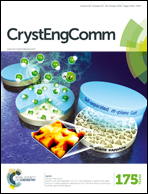Diverse structural assemblies of silver–thiophene-2,5-dicarboxylate coordination complexes contribute to different proton-conducting performances†
Abstract
Three 2,5-tpa complexes [Ag(PPh3)2(2,5-tpa)]n (1), [Ag2(2,5-tpa)(2-apy)2]n (2) and [{Ag2(2,5-tpa)(hmt)2}·3H2O]n (3) have been obtained and characterized by single-crystal X-ray analyses, elemental analyses, IR spectroscopy, and TG and proton-conductivity analyses, where 2,5-tpa stands for thiophene-2,5-dicarboxylic dianions, PPh3 is triphenyl phosphine, 2-apy is 2-aminopyridine and hmt is hexamethylenetetramine. The structures of 1–3 adopt 1D to 3D frameworks. Complex 1 is a one-dimensional sandwich-like polymer containing a 1D semi-symmetric ham backbone made up of [Ag(2,5-tpa)] units and PPh3 “bread layers”. In complex 2, the 2,5-tpa ligands bridge Ag atoms to form a 2D fishbone-shaped layer with weak π⋯π interactions and intra-molecular N–H⋯O hydrogen bonds. In 3, the 2,5-tpa ligands bridge two Ag-hmt layers to form a 3D wavy structure. Topological analyses were performed and the results are a 5-c nov net, a 3,4-c {6·102}{62·104} net and a 3,4,6-c {44·54·62·74·10}{5·62}2{52·63·7}2 net for 1–3, respectively. The structural diversity of the complexes results from the different neutral ligands in the structures, which has an important impact on the proton conductivities of the complexes. The complexes exhibited superprotonic conductivities of 1.99 × 10−2 S cm−1 for 1, 4.25 × 10−3 S cm−1 for 2 and 1.98 × 10−3 S cm−1 for 3 at room temperature in a KNO3–K4Fe(CN)6–K3Fe(CN)6 electrolyte. The proton conductivities of polymer films from 1 and 2 with PVDF (polyvinylidene fluoride) are 2.17 × 10−3 S cm−1 and 8.99 × 10−4 S cm−1, respectively.


 Please wait while we load your content...
Please wait while we load your content...